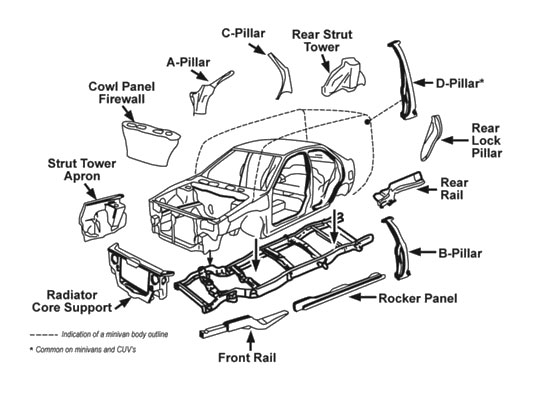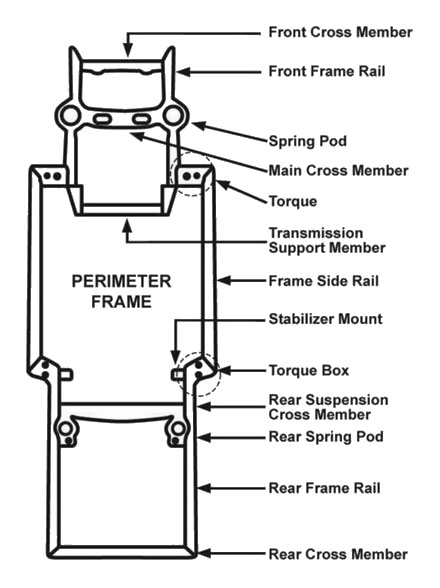F.A.Q.’s
Frequently Asked Questions
This flow chart was designed to help keep you informed of the sequence and repair process of your vehicle. Our commitment is to return your vehicle to you as quickly as possible and in pre-accident condition. Should you have any additional questions, please ask one of our service advisors. Thank you once again for choosing our shop to repair your vehicle.
Our mechanics typically straighten frames with a frame-straightening machine. The mechanic drives the car onto a platform on this machine, and then uses clamps to secure the car to the platform to prevent damage to the car, it must be secured at all times during the straightening process. The machine also has two or three pulling towers with chains. The mechanic attaches these chains to the car frame where it needs to be straightened, and uses hydraulic equipment in the pulling tower to pull on the chain. The mechanic increases the hydraulic power until the chain pulls enough to straighten the frame.
Since clamps and chains attach to the car, the mechanic should check these before each use. If any clamp or chain is worn, the mechanic should replace it. He should also replace this equipment periodically, even if there isn’t visible wear. He must check the hydraulic fluid before each use so the pulling towers work correctly. The mechanic measures the whole car before performing any repairs to assess the damage and determine what parts of the frame require straightening.
Paintless dent repair works by pressing the dented metal back into its normal shape by working from the unfinished side of the metal while applying a second tool to the outside of the car. The process requires specialized tools and a skilled individual to do the work. Typically, companies offer this service at about one-third of the cost of a painted repair.
Paintless dent repair has some limitations. It works best on small dents. Damage that involves the car frame or that causes holes or tears in the metal is not a candidate for this type of service. The results vary, even when the same repair person does the work.
Most repairs use less time and material, resulting in a lower cost. While repairs are cosmetically perfect, repairing a dent in this method does not restore the strength lost when the dent occurs. A subsequent accident in the same area often results in more damage than if the car had traditional body repair work.
Often, the simplest way to get you into a rental car is to get a rental through your own insurance policy, if you have rental coverage.
Alternatively, you may pay out-of-pocket for your rental then seek reimbursement from the other insurance company once it completes its investigation.
It is entirely appropriate for the insurance company to provide you with a rental vehicle that is comparable to the vehicle being repaired or totaled, particularly in situations where you require a particular type of vehicle for your job or business.
Be mindful that most collision policies do not allow for endless rental coverage. You are normally allowed to rent a vehicle until your vehicle is repaired, or until the insurance company issues you payment in a total loss situation provided that such coverage is included in your insurance policy.
You have a right to use any rental provider or location you choose. If you choose another rental provider you may have to pay the cost upfront. Typically your auto insurance company will reimburse you up to the limits of your rental reimbursement coverage. Ask the rental company if direct billing is available. In all cases you may be subject to providing a credit card to meet the rental company’s security deposit requirement.
Most rental car providers will ask you to purchase additional insurance from them to cover the rental car. Keep in mind, if you have comprehensive and collision coverage on your auto insurance policy, it will usually transfer over to your rental car while your vehicle’s accident damage is being repaired.
You should decide for yourself if you want to purchase insurance coverage from the rental provider. Your auto insurance company representative can provide more information and assist you with this decision.
In most states, you can rent a car that is comparable in size to your own vehicle. However, if the daily rate of your rental car is more than your daily limit, you will most likely have to pay the difference.
Also, if your vehicle repairs are going to take several weeks, you may want to rent a car with a lower daily rate so your rental reimbursement limit will last longer.
Again ask your insurance and/or car rental company about options that are best for you.
We offer all customers shuttle service to and from our customer’s preferred location for up to 10 miles from the shop. Customers can ask for courtesy shuttle when setting an appointment but if they drop-in we will do what we can to make those accommodations as well.
During our business hours we are able to get the best towing at the best prices. Just call us and we will coordinate this service for you. After hours call the tow company directly and they will drop your vehicle here in the morning.
You don’t need to waste time on the phone with your insurance company to see if you can call us. We work with ALL insurance companies! We will provide them with an estimate and handle the insurance paperwork, so you have two fewer things to worry about.
This happens when any part of the vehicle which is part of the main body or frame, or is designed to ensure structural integrity, is damaged. Even minor car frame damage from a trivial collision can seriously undermine the structural integrity of a vehicle.
Examples of vehicle components which are part of the body or frame include suspension mounting, lower and upper frame rails, and for unibody vehicles, the A, B and C pillars, windshield, rear window frame and rocker panels.
Anything which can be bolted on is not considered part of the underlying structure.
Cars have either a unibody or frame construction.
Unibody construction
Unibody construction, where the body and frame are made from one piece of metal, is now the most common structure for cars. Its benefits include a lower body weight and protecting passengers from the force of impact in a crash.

Frame construction
Frame construction is when the vehicle’s frame is made of steel and then the body is mounted on top of it. Although unibody construction is now more popular, this method was used extensively in the past and is still used on some models.

This happens when a car is hit at a crucial part of its structure, causing bending, shifting, cracking or other damage. A ripple effect can take place, when even minor damage to one part of the body leads to damage and weakening in other areas.
Damage to the car’s body is always concerning because it can affect passenger safety if it is involved in another accident.
In modern unibody vehicles with crumple zones that protect the passenger compartment, this is because once the crumple zones have been damaged they are permanently weakened. If the car crashes, these crumple zones will behave unpredictably, which can also cause the airbags to deploy at the wrong time.
Underlying structural weaknesses can mean that greater damage is caused to the car in an accident.
You should check for the following signs of frame damage:
- Clamp marks, which are holes or gashes on the frame, indicates a wrecked car repaired using a straightening machine
- Replacement hood, trunk, windows or doors
- Unusual engine noise, as a major accident can affect the engine
- An inconsistent finish or rough paint line, particularly under the hood, caused by repainting after repairs
- Doors, windows, hood or trunk which don’t close properly
- Welding marks under the hood
If you suspect frame damage, get a collision repair facility inspection from one of our qualified mechanics. We use lasers to measure your vehicle’s body to the millimeter and compare it to the manufacturer’s specifications.
When your vehicle is damaged in a collision, an estimate is not the first thing that you should obtain. The first order of business is to determine who will pay for the damage. In most cases, your vehicle will require some disassembly of damaged parts in order for us to produce an accurate estimate of your damage.
Because of this, the estimating process is affected by the needs of the paying party. All insurance companies have different claims procedures and we will let you know the most efficient way to handle your claim. In addition, we will assist you with the claims process.
You don’t need to run around wasting your time gathering estimates and claims handling. Many times it is better to leave the car with us and have the insurance company inspect it with us; this can prevent discrepancies that may delay repairs.
All you will need to bring is your insurance company claim number and the name of the contact person.
We will handle it from there.
Do you have questions we didn’t answer? Give us a call or send us an email.
We’d love to talk with you and answer your questions in more detail!
Woori / Gwinnett Auto Body
3620-B Lawrenceville-Suwanee Rd.
Suwanee, GA. 30024
Tel: (1) 678-313-9444
Fax: (1) N/A
E-mail: contact@wooriautobody.com
Web: https://wooriautobody.com
Search the Site
Company Contact Info
Location
Woori / Gwinnett Auto Body
3620-B Lawrenceville-Suwanee Rd.
Suwanee, GA. 30024
Phone & Fax
Phone: (1) 678-313-9444
Fax: (1) 404-745-8873

